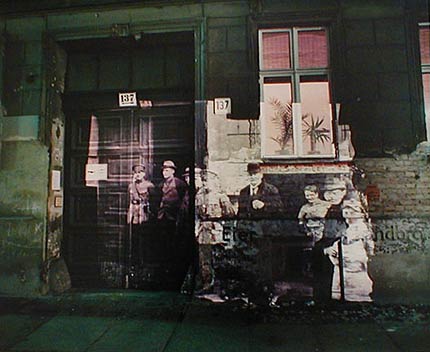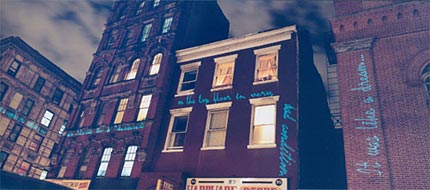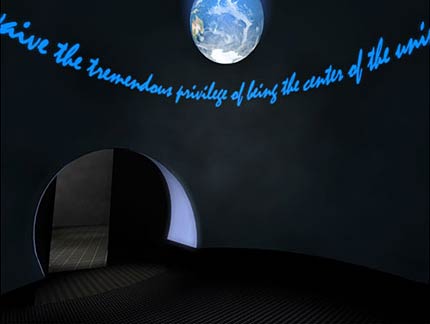Interview with Shimon Attie
by Irit Bastry
Irit Batsry: Before we start this conversation could you please describe your Berlin, Copenhagen and Manhattan's Lower East Side projects, as an introduction to some of the themes and concerns that inform your art practice?Shimon Attie: In "Writing on the Wall", 1992, I slide projected black and white historical photographs of Jewish street life from before the war onto the very same — or near by addresses in Berlin 60 years later. I then took photographs of the projection interacting with the architecture.
For "Portraits of Exile", 1995, I created an underwater installation with 9 transparency images mounted on very large light boxes. These light boxes where submerged about 1 meter underwater in one of the central canals of Copenhagen, right in front of the Danish Parliament building. On each light box there was two collaged images together. One was a portrait and the second was some kind of background image to give context. I created a situation where historical human rights tales were coexisting with a present day human rights challenge. The historical story was the Danish rescue of their Jewish community on fishing boats in 1943.
In Manhattan's Lower East Side I did a project sponsored by Creative Time called "Between Dreams and History". I interviewed about 75 residents of the Lower East Side from all different age groups and from all the main ethnic immigrant groups (Latino, Chinese and older Jewish residents). I formulated a series of questions and asked members of this community to write down the answers in their native tongue. The questions were trying to tap into a collective imagination: "Have you ever had a sleeping dream about your neighborhood?" "Can you remember your favorite nursing rhyme from childhood?". The hundreds of responses were edited to 28 texts and using computers an advanced laser technology, their hand written memories were written out as if a ghost was writing on the architecture of two city blocks.

Linienstrasse 137: Slide projection of police raid on former Jewish residents, 1920, Berlin, 1992, On-location Installation and 33"X40" chromogenic photograph, from the project The Writing on the Wall, courtesy of Jack Shainman Gallery, New York City
IB: You came to fine art from psychology — could you talk about specific instances in which this background was important, helpful or harmful?
SA: Chronologically it is true, I committed myself to being an artist after being a psychologist, but I don't think that I came to one from the other. I would rather say that it's a similar part of temperament that led me to psychology and later to art. I don't attribute very much the way I think or my way of being in the world to my training in psychology; I attribute it rather to my sensibility, which predates any specific professional involvement. I am somebody for whom memory is very important, on a personal level.

I remember when we lived in a tenement on the top floor in very bad condition. It was like a dream... Lasers Writing Out Elder Resident's Memory, On-location Laser Projection Installation and 23 3/4" X 65" chromogenic photograph, from the project "Between Dreams and History", presented by Creative Time, New York City, 1998
IB: Do you remember at what age that started to become so?
SA: When I was a child.
IB: When you became interested in your family history, or when you were trying to find stories about it?
SA: As a child I was told many stories about people that I never knew. About people that had died before I grew up. I remember having the feeling of having lost something that I never had. It was a very peculiar sensation.
IB: In a previous conversation you told me that your mother's family came from Germany and Russia. Is it this the side of your family that disappeared in the holocaust?
SA: My direct family had come to America before the holocaust. My proximity to and knowledge of these stories was passed to me by my father and some of his friends who where survivors of the holocaust. But my work is more about memory than about any specific historical event. In certain contexts some distillations of the content come more to the forefront. Issues that come to the forefront in Europe, such as references to WWII are very different from those that come forth in America, which are often about how multicultural memories are interacting, commingling and dialoguing with each other.

Present day refugee with dormitory ship ("Flotel Europa") used to house refugees in Copenhagen harbor, 1995, 2 X 1.75 meter "fuji-trans" photograph mounted on light box submerged 1 meter under water, Borsgraven Canal, Copenhagen, Denmark, courtesy of Jack Shainman Gallery, New York City
IB: Are you interested in the process of forgetting as well?
SA: Yes, the process of memory and the process of forgetting are inseparable. I've never felt like I've had to articulate the process of forgetting partly because I feel this process occurs by default. I think the best way to shine light on it is to intervene in situations where it is operating rather than to interrupt it.
I am interested in trying to expand the layers of fabric through which we experience things. I am trying to fill up these layers and the richness of things. Simply because something is not visible it doesn't mean that it is not there.
IB: It sounds like you are exposing layers, things that have always been there. Can you talk about the connection of your work to the documentary?
SA: Curiously, yesterday I was talking to some students about how my work lives in an arena between "the document" on the one hand and the "fine art object" on the other hand. This is more in relationship to the medium of photography though. My work blends these two opposites; I use documentary type images from archives, for example, and I reconfigure and introduce them into a different visual and contextual field. I use images as signifiers that point to layers of history, lost communities or a latent collective whispering within a certain context.
What I find most interesting about this question is the next level to it, which is the issue of the treatment of historical facts. I am not a historian, I am not a politician, I am not a pedagogue and I am not a sociologist. I try to use a visual language in my work that allows people to have a different kind of visceral, intellectual and aesthetic experience that would be different from a direct frontal confrontation with the historical facts.
My early projects had an element of very tight site specificity. They referenced true historical events. Over the years my work has become much about literature, fiction or visual poetry. I am trying to create an experience.
IB: Is that attempt to create an experience what has led you to make projects that rely on complex technology?
SA: I am completely not interested in technology but in order to create a certain kind of ethereal aesthetic, which I feel it's appropriate to the concept of many of my pieces- in order to do that effectively- I've had to use fairly sophisticated technology.

At Temple of Fortuna, On-location slide projection and 50"X60" lambda photograph, Rome, Italy, 2003 from the series The History of Another, courtesy of Jack Shainman Gallery, New York City
IB: Does working with these technologies alter your creative process?
SA: Yes, it does. It slows down the lag time between conception and realization.
IB: Would you be interested in making work about the future?
SA: I am doing a project for the National Oceanic and Atmospheric Administration (NOAA) in Washington. They are building a new space satellite control center where many of the images of planet earth will be downloaded from NOAA's satellites. I was invited to create the artwork for this building. This work is about the future in the sense that it will be permanent work. Some aspects to the content are oriented in that direction. I am going to ask certain people to imagine a possible future for the planet earth, the mission of this building, the monitoring of earth, etc...
IB: What is the difference for you between working in outdoor public spaces using historical material and working in a project, which will be a completely artificially constructed space indoors?
SA: There's much greater control indoors over serendipitous events. When you create a completely artificial environment it lends itself to a more phantasmic journey.
IB: Can you talk about the public's reactions to your works "The Writing on the Wall" done in Berlin and "Between Dreams and History" done in the Lower East Side of New York City? In which way do you think these works transformed the relationship of the viewers to these places?
SA: I left Berlin almost 10 years ago. When I return in the present time I find people that remember the projections and tell me that these images come to their minds every time they walk by the specific places. I find it interesting in that it points to the power of a temporary intervention, as opposed to a static permanent one.

Design Rendering (view looking back; laser write-out "complete"), Permanent new media art Installation (near-live full-earth satellite feed, 3-dimensional volumetric projection, animated laser projection, back-lighting and audio sited within translucent spherical chamber constructed from resin), new Space Satellite Control Center, the National Oceanic and Atmospheric Administration (NOAA), Washington, DC, 2005, realized in collaboration with Norman Ballard
IB: Did you ever feel that you shouldn't have done some of your projects because they stirred memories that, perhaps, weren't ready to be stirred?
SA: Only in Germany. I was even assaulted. I never felt I was trying to provoke people. I am neither a propagandist nor a pedagogue. I am not trying to teach a lesson, I am trying to create opportunities for reflection. I understand that within the German context the kind of work I presented is very charged and loaded. The New York project was in a sense sweet and also more poetic.
IB: In "Portraits of Exile", the work you did in Copenhagen in 1995, you had light boxes with portraits submerged under the water of the Borsgraven Canal. Can you speak about the relationship between the element of water and memory?
SA: Water is a medium of memory. Water is a perfect mirror for how memory operates: it's clear, then it is cloudy, murky, deep, calm, turbulent, it floats away? Water is also a medium for projection. The relationship between projection and memory is a curious and complicated one.
IB: Can you speak about the relationship between text and images in your work?
SA: Earlier when I spoke about my sense of time and memory I could have said that my boundaries between past, present and future are perhaps more porous than other people's. I think the same is true about text and image. Text is an image for me; when I use it visually I insist on it having the right quality. Words are images.
IB: What can text do that an image can't?
SA: I never project text. I am interested in having the text written out by an unseen hand. That animates the text for me. What this does that an image can't is that it creates the perception of an unseen hand, an unseen author. The words are alive and they are written out now.
IB: Usually one associates a written thing with something that has been already said.
SA: This loosely parallels what I do with documentary images. It is a frozen moment in time that I am reintroducing as a layer within a contemporary situation.
IB: If you were to invent a parallel artist, one that would do work completely different than the one you are known for, what would this artist do?
SA: I know exactly what that other artist does. What he does is close to what I do. He does video installations that have a sculptural element to it. I am very interested in how projected images interact with surfaces, and how both the surface and the image change as a result.
All images courtesy of the artist and Jack Shainman Gallery, New York
© Irit Batsry- Shimon Attie 2004